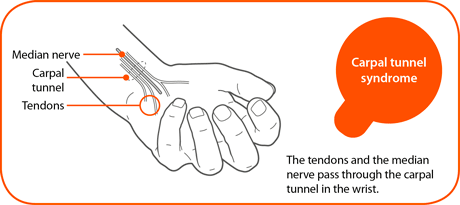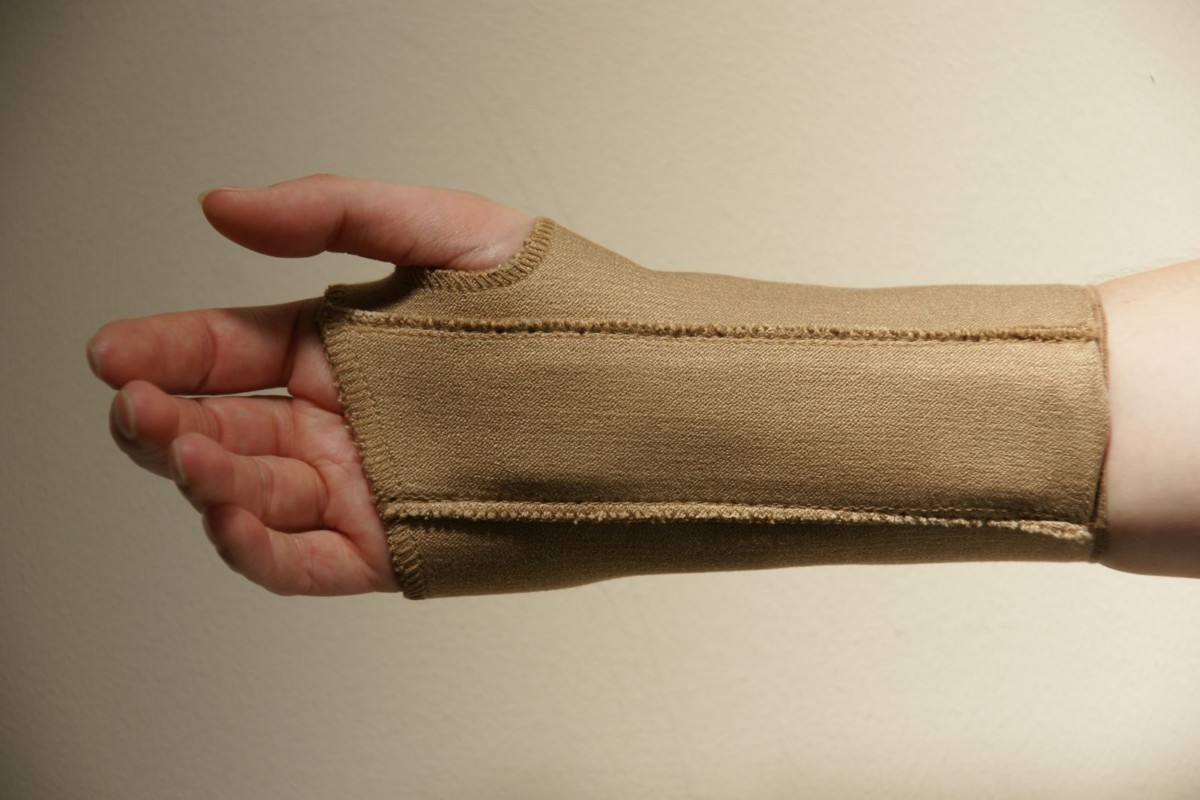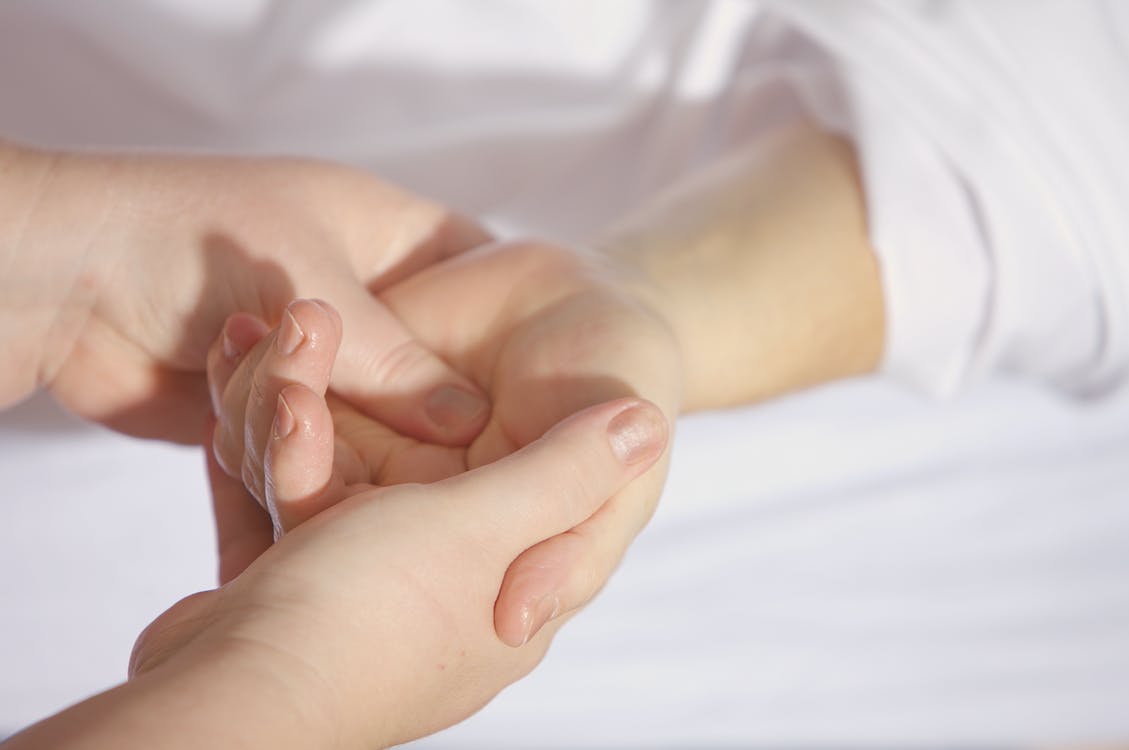An overview
Carpal Tunnel Syndrome is a term given to a collection of symptoms that present themselves when the median nerve, upon passing through the wrist and into the hand, is put under uncomfortable pressure. The median nerve itself is responsible for the control of the muscles that move the thumb. It also relays signals to the brain, telling it about the feelings in one’s thumb and fingers. The carpal tunnel itself is located on the palm side of one’s wrist – made up of carpal bones and ligaments, the median nerve travels through the tunnel on its connection to one’s hand. It is here that the symptoms present themselves. You can read an extended description of carpal tunnel syndrome.

The median nerve and carpal tunnel pathway, as depicted by Arthritis Research UK.
Who’s at risk of Carpal Tunnel?
One’s dominant hand is usually the first to display symptoms of carpal tunnel. Those suffering with conditions such as diabetes, thyroid, autoimmune disorders and high blood pressure are also at higher risk of developing the condition. With regards to diabetes, some researchers have reason to believe that an increase in blood glucose levels can lead to the glycosylation of the tendons in the tunnel itself.
Research indicates that the development of carpal tunnel syndrome can be up to three times likelier in women than men. The suggested likelihood is that, anatomically, the carpal tunnel itself could be smaller in women. It only tends to present itself amongst adults, which gives reason to believe that the syndrome can occur as a result of repetitive wrist action over time. Therefore, although the overall risk of developing carpal tunnel syndrome is in no way restricted to a particular line of work, researchers have picked up on prevalence trends surrounding those who work in the manufacturing industry.
What are the symptoms of Carpal Tunnel?
There tends to be a steady increase in the frequency and severity of carpal tunnel symptoms. One may experience sensations of itching numbness in the thumb and fingers to begin with. This generally excludes the little or ‘pinky’ finger, as it is attached to the ulnar nerve, while CTS is associated with the median nerve and its journey through the carpal tunnel in the wrist. The numbness can be accompanied by “pins and needles” like tingling, and mild burning sensations. The severity of the symptoms correlates with the thickness of the carpal bones; the more pressure on the median nerve, the greater the symptoms are likely to be.
Symptoms typically manifest themselves during the night. The morning may see CTS sufferers feel a need to exercise the numbness out of their hands by shaking or stretching. To begin with, this may help ease the pressure. The video below demonstrates three very routine exercises that can help provide some respite from carpal tunnel syndrome.
Later, one may begin to experience the symptoms throughout their daily life. This will happen if the median nerve becomes badly compressed by the tunnel’s tendon and bone structure. The most prevalent example of this would be a loss of strength when gripping onto items. As the muscle mass at the base of the thumb begins to deteriorate, CTS sufferers will lose the ability to form a secure grip on common objects. This can prove problematic in the work place just as much as it can at home.
How does one get diagnosed with Carpal Tunnel?
Test
As CTS presents itself with crossover symptoms that are applicable to a variety of conditions, from time to time there can be a misdiagnosis. To ensure that the diagnosis is correct, one’s GP or doctor may undertake a nerve conduction test. With this, one of the affected fingers will be stimulated with a minor electrical current. As the median nerve responds to the current, a recording is taken. A slower response between the probed finger and median nerve in the wrist is an identifiable trait of carpal tunnel syndrome. GP’s and doctors will be eager to carry this out to ensure the problem doesn’t lie elsewhere. Pressure on nerves elsewhere in the body, especially in the neck area, can also produce similar symptoms with more devastating long term effects. Below is an example of a quick nerve conduction test.
Examination
One’s GP or doctor will want to examine the affected hand and wrist. This is in the interest of determining the exact cause of the symptoms, and how developed they are. Expect a GP or doctor to assess the wrist for signs of arthritis or tendon inflammation. They may also pin prick the fingers to determine numbness, or perform a Tinel’s test whereby the median nerve is tapped to create a sensation of pins and needles.
How is Carpal Tunnel treated?
Firstly, it is worth noting that CTS has been known to clear itself up over the span of a couple of months. If one is experiencing mild symptoms early, then it may be worth working on some home remedies mixed with abstaining from activities that may be an issue.
An example of carpal tunnel treatment is wearing a wrist splint to keep the wrist straight can help relieve the compression on the median nerve. Doing so throughout the night can have positive effects as it works to release pressure. Wrist splints can be purchased over the internet, but it is recommended that one travels to a local pharmacy where they can be advised on the correct product. Using a splint does not bring around immediate positive effects, one may not experience a release from CTS symptoms for at least a month.

Example of a common wrist splint. Credit: carpal-tunnel.net
For more immediate relief, a Cortisone injection can be administered to fight inflammation. This, however, onlyworks against CTS symptoms temporarily and does not provide a long term fix for the condition.
Severe cases of carpel tunnel syndrome may require surgical action to relieve the pressure being placed on the median nerve. The transverse carpal ligament is cut to release the pressure, and it is accessed through an incision approximately 3-4 cm in length. The procedure in its entirety takes between ten and fifteen minutes, with post-surgical hand elevation required for 48 hours to lower the risk of swelling.

